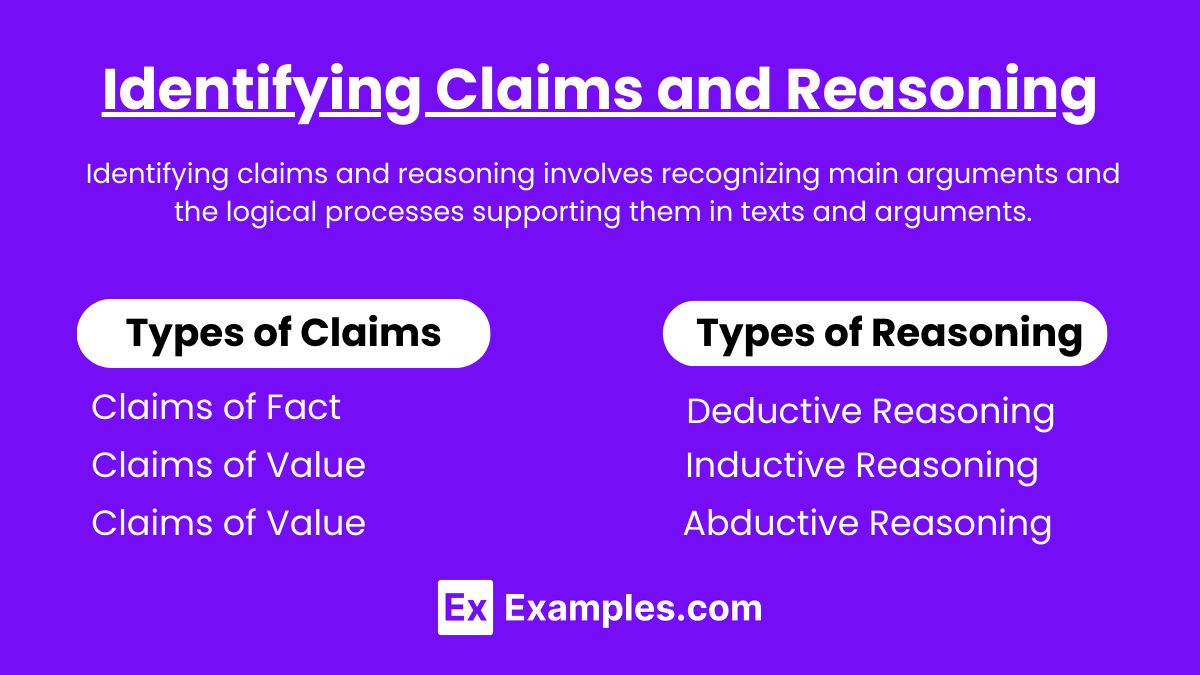In AP English Language and Composition, identifying claims and reasoning is a fundamental skill that enables students to analyze and construct persuasive arguments. Recognizing the main assertions (claims) and understanding the logical processes (reasoning) that support these assertions are crucial for effective rhetorical analysis of essays and crafting robust argumentative thesis statements. This skill enhances critical thinking and the ability to engage in persuasive communication, equipping students to dissect complex texts and develop coherent, compelling essays. Mastering the identification of claims and reasoning not only prepares students for academic success but also empowers them to navigate and influence real-world discussions with clarity and precision.
Learning objectives
The learning objectives are to analyze and identify claims and reasoning in texts, enhance critical thinking, craft coherent argumentative thesis statements, conduct effective rhetorical analysis of essays, and develop skills for persuasive communication in both academic and real-world contexts.
Understanding Claims
Definition:
A claim is a statement that asserts a belief or truth. In an academic essay, a claim is the main argument or point that the writer is trying to make.
Types of Claims:
- Claims of Fact: Assert that something is true or false.
- Example: “Climate change is a significant threat to global ecosystems.”
- Claims of Value: Assert the worth or value of something.
- Example: “Art education is essential for developing creativity in students.”
- Claims of Value: Advocate for a specific course of action or change in policy.
- Example: “The government should implement universal healthcare.”
Argumentative Thesis Statement:
An argumentative thesis statement presents the main claim of an essay and outlines the writer’s position on the topic. It guides the direction of the essay and informs the reader of what to expect.
Example: “Mandatory recycling programs are necessary to reduce environmental pollution and conserve natural resources.”
Understanding Reasoning
Definition:
Reasoning refers to the logical processes used to connect evidence to a claim. It involves the use of critical thinking to construct coherent arguments.
Types of Reasoning:
- Deductive Reasoning: Starts with a general statement and moves to a specific conclusion.
- Example: “All men are mortal. Socrates is a man. Therefore, Socrates is mortal.”
- Inductive Reasoning: Starts with specific evidence and moves to a general conclusion.
- Example: “Every swan we have seen is white. Therefore, all swans are probably white.”
- Abductive Reasoning: Begins with an incomplete set of observations and proceeds to the likeliest possible explanation.
- Example: “The grass is wet. It probably rained last night.”
Identifying Logical Fallacies
Definition:
A logical fallacy is an error in reasoning that weakens an argument. Recognizing these fallacies is crucial for rhetorical analysis of essays.
Common Logical Fallacies:
- Ad Hominem: Attacking the person instead of the argument.
- Example: “You can’t trust his opinion on climate change; he’s not a scientist.”
- Straw Man: Misrepresenting an argument to make it easier to attack.
- Example: “People who support space exploration just want to waste money on useless projects.”
- Appeal to Authority: Using an authority figure’s opinion as evidence.
- Example: “This must be true because a famous scientist said so.”
Analyzing Rhetorical Devices and Techniques
Definition:
Rhetorical devices are techniques used by writers to persuade or convey meaning effectively. Identifying these devices is key to understanding the rhetoric sentence and the overall persuasion in communication.
Common Rhetorical Devices:
- Ethos: Appeals to the author’s credibility.
- Example: “As a doctor, I am qualified to tell you that this treatment is effective.”
- Pathos: Appeals to the audience’s emotions.
- Example: “If we don’t act now, future generations will suffer.”
- Logos: Appeals to logic and reason.
- Example: “Statistics show a 30% increase in recycling rates with mandatory programs.”
Writing and Analyzing Case Summaries
Definition:
A case summary provides a concise overview of a particular case or situation, highlighting the main claims and reasoning.
Components of a Case Summary:
- Background Information: Context and relevant details of the case.
- Main Claims: The primary assertions made in the case.
- Evidence and Reasoning: The support and logic used to back up the claims.
- Conclusion: The final outcome or implications of the case.
Crafting a Rhetorical Analysis Essay
Definition:
A rhetorical analysis essay examines how authors use rhetorical devices and strategies to persuade their audience.
Steps to Write a Rhetorical Analysis Essay:
- Introduction: Present the text being analyzed and its context. Include a thesis statement outlining the main points of analysis.
- Body Paragraphs: Analyze specific rhetorical devices and strategies used in the text. Discuss how they contribute to the author’s purpose and effectiveness.
- Conclusion: Summarize the main points of analysis and restate the thesis in light of the discussion.
Persuasion in Communication
Definition:
Persuasion is the act of convincing others to believe or do something. In writing, it involves using logical arguments, emotional appeals, and credible evidence.
Key Elements of Persuasion:
- Clarity of Claims: Ensure your main points are clear and well-defined.
- Strength of Reasoning: Use sound logic and evidence to support your claims.
- Engagement of Audience: Use rhetorical devices to connect with your audience and persuade them effectively.
Practicing Critical Thinking
Definition:
Critical thinking involves analyzing and evaluating information and arguments in a disciplined and systematic way.
Techniques for Critical Thinking:
- Questioning Assumptions: Challenge underlying assumptions in arguments.
- Evaluating Evidence: Assess the credibility and relevance of evidence.
- Recognizing Biases: Identify potential biases in sources and arguments.
By mastering the skills of identifying claims and reasoning, recognizing logical fallacies, and analyzing rhetorical devices, you will enhance your ability to craft and critique arguments effectively in AP English Language and Composition. These skills are essential for developing strong argumentative thesis statements, conducting rhetorical analysis of essays, and engaging in persuasive communication.


